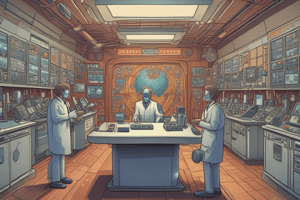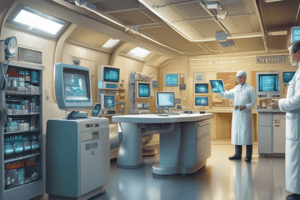Podcast
Questions and Answers
All radiopharmaceuticals are used for diagnostic purposes only.
All radiopharmaceuticals are used for diagnostic purposes only.
False (B)
Radionuclides are produced in nuclear reactors and hospitals.
Radionuclides are produced in nuclear reactors and hospitals.
False (B)
Radiopharmaceuticals are administered topically and orally.
Radiopharmaceuticals are administered topically and orally.
False (B)
The term radiopharmacy is also used for the laboratory where these activities are carried out.
The term radiopharmacy is also used for the laboratory where these activities are carried out.
Radioisotopes are naturally occurring unstable atoms of a naturally occurring element.
Radioisotopes are naturally occurring unstable atoms of a naturally occurring element.
There are over 500 radioisotopes known to occur.
There are over 500 radioisotopes known to occur.
All radioisotopes are naturally occurring.
All radioisotopes are naturally occurring.
The half-life of a radioisotope determines the rate of conversion to its stable elemental composition.
The half-life of a radioisotope determines the rate of conversion to its stable elemental composition.
Radiopharmaceuticals are prepared by doctors in a hospital setting.
Radiopharmaceuticals are prepared by doctors in a hospital setting.
The high-energy radiation released by radiopharmaceuticals is used to destroy healthy cells and tissue.
The high-energy radiation released by radiopharmaceuticals is used to destroy healthy cells and tissue.
Radiopharmaceuticals are used to accumulate in healthy tissues and cells in the body.
Radiopharmaceuticals are used to accumulate in healthy tissues and cells in the body.
Radiopharmaceuticals are regulated only as medicinal products.
Radiopharmaceuticals are regulated only as medicinal products.
In beta plus decay, a neutron decays into a proton, an antineutrino, and a positron.
In beta plus decay, a neutron decays into a proton, an antineutrino, and a positron.
The atomic number of the daughter nucleus is always one more than the parent in beta decay.
The atomic number of the daughter nucleus is always one more than the parent in beta decay.
In electron capture, an orbiting electron combines with a nuclear neutron to form a proton and a neutrino.
In electron capture, an orbiting electron combines with a nuclear neutron to form a proton and a neutrino.
The total number of nucleons always changes in beta decay.
The total number of nucleons always changes in beta decay.
Tritium decays to radioactive helium through alpha decay.
Tritium decays to radioactive helium through alpha decay.
In beta minus decay, a proton decays into a neutron, an electron, and an antineutrino.
In beta minus decay, a proton decays into a neutron, an electron, and an antineutrino.
Beta particles have an energy of 1 MeV.
Beta particles have an energy of 1 MeV.
Beta minus decay results in a decrease in atomic number.
Beta minus decay results in a decrease in atomic number.
Gamma rays are the least penetrating electromagnetic radiation.
Gamma rays are the least penetrating electromagnetic radiation.
Beta plus decay occurs in fission nuclear reactors.
Beta plus decay occurs in fission nuclear reactors.
Gamma radiation is produced by the decay of stable nuclei.
Gamma radiation is produced by the decay of stable nuclei.
Positrons are emitted during beta minus decay.
Positrons are emitted during beta minus decay.
One curie is defined as 3.7 x 10^9 atoms disintegrating per second.
One curie is defined as 3.7 x 10^9 atoms disintegrating per second.
The microcurie is one thousandth of a curie.
The microcurie is one thousandth of a curie.
The becquerel is equal to 10^3 disintegrations per second.
The becquerel is equal to 10^3 disintegrations per second.
The rad is a unit of measurement for radioactivity.
The rad is a unit of measurement for radioactivity.
The kilobecquerel is equal to 10^6 disintegrations per second.
The kilobecquerel is equal to 10^6 disintegrations per second.
One erg is equal to 10^-8 Joules.
One erg is equal to 10^-8 Joules.
Flashcards are hidden until you start studying
Study Notes
- In beta decay, the total number of nucleons remains unchanged, and the process occurs when an atomic nucleus is unstable due to having too many protons or neutrons.
- Beta minus decay (β-) involves a neutron decaying into a proton, an antineutrino, and an electron, resulting in an increase in atomic number by one.
- Beta plus decay (β+) involves a proton decaying into a neutron, a neutrino (ν), and a positron, resulting in a decrease in atomic number by one.
- Electron capture is a process where an orbiting electron combines with a nuclear proton to form a neutron and a neutrino, resulting in a decrease in atomic number by one.
- Radiopharmaceuticals are medicinal products containing radionuclides, produced in nuclear reactors or cyclotrons, and are used for diagnostic, therapeutic, or palliative purposes.
- The most important radionuclides used in nuclear medicine are 99mtechnetium and 18fluoride.
- Radiopharmaceuticals are administered parenterally, orally, or by inhalation, and when used for diagnostic purposes, minute quantities are used to accumulate in target tissues and emit gamma-radiation.
- The curie (Ci) is the basic unit of radioactivity, defined as that quantity of a radioisotope in which 3.7 x 10^10 atoms disintegrate per second.
- The becquerel (Bq) is the International System (SI) unit for radioactivity, defined as 1 disintegration per second.
- Units of radioactivity include the kilobecquerel (kBq), megabecquerel (MBq), and gigabecquerel (GBq), which are multiples of the becquerel unit.
- One rad represents the amount of radiation that releases energy of 100 ergs per gram of matter.
- Radioisotopes are produced by bombarding the atoms of stable, naturally occurring elements with fast-moving neutrons, and most radioisotopes are not naturally occurring.
- Radioisotopes tend to revert to their natural, stable elements at a rate specific to each isotope, measured by half-life, the time it takes for half of the radioisotope population to convert.
- In a hospital setting, radiopharmaceuticals are typically handled by the nuclear pharmacy or radiopharmacy, and are prepared, tested, and released under the responsibility of a (radio) pharmacist.
- Radiopharmaceuticals are regulated both as medicinal products and as radioactive substances.
Studying That Suits You
Use AI to generate personalized quizzes and flashcards to suit your learning preferences.




